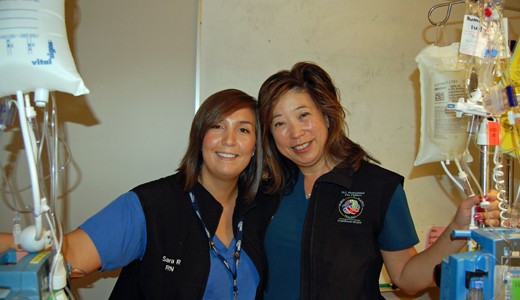“It’s made me such a better nurse”
“It’s made me such a better nurse,” says Sara Ruiz.
In February 2014, Sara left the Neuro ICU and began working in what was then the Burns, Plastics and Trauma Unit at VGH. She hasn’t looked back since.
“I didn’t know what to expect, but it’s been the best thing to happen to me. I’ve discovered a whole new world below the head.”
Now, Sara says, she’s more excited than ever — and with good reason.
In September, the new High Acuity Unit (HAU) at VGH began accepting admissions. The HAU operates alongside the high-acuity Burns and Trauma beds and, collectively, the unit space is now referred to as the Burns, Trauma and High Acuity Unit (BTHAU).
“As a nurse, I love the idea of building on my high-acuity training,” Sara explains. “I look forward to new responsibilities, working alongside intensivists and quality time with patients.”
High-acuity care for high-risk patients
Dedicated to patients requiring a high level of care, including frequent monitoring and interventions, the HAU focuses on the specific needs of a high-risk population.
“The HAU represents an entirely new service at VGH,” says Dr. George Isac, medical director, Intensive Care Unit (ICU). “Apart from speciality care units like the Neuro ICU and Spine Stepdown Unit, this is the first VGH unit for intermediate patients — patients too sick for the wards and too well for the ICU.”
In the HAU, an interdisciplinary team with high-acuity training cares for patients at risk of deteriorating. The results, says Dr. Isac, will be safe, quality care for improved patient outcomes.
Dr. Hussein Kanji, an intensivist, agrees. At Royal Columbian Hospital, he saw the difference an HAU can make. “Patients benefit from more frequent rounding and closer monitoring,” he explains. “Should a patient’s condition deteriorate suddenly, the team’s in place to change the trajectory quickly.”
ICU intensivists will triage and oversee the care of all HAU patients. “We’re leveraging the expertise of all paramedical staff across both units, and we’re excited to be working as a cohesive team for our patients,” Dr. Kanji says.
“The HAU’s mission blends perfectly well with our Critical Care Outreach Team, too,” adds Dr. Isac. Like CCOT, the HAU provides a safety net to all wards and, over time, the unit should help ease congestion in the Emergency Department.
A study of professionalism
In preparation for the HAU opening, all RNs with a high-acuity certificate augmented their expertise with advanced critical care skills training. And that’s not all. Sara hosted a Jeopardy!-style study group at her home. “We’re a close-knit group and we enjoy helping each other out and working off each other’s strengths,” she says.
“I’m extremely proud of all staff who have been a part of this transition,” says Michelle de Moor, operations director for the new BTAHU. “Their willingness to engage in education, training and orientation – both as participants and as mentors – is inspiring.”
If Sara has any say, September’s study group was just the beginning. “We’re all really excited about the future. If all goes well, maybe we’ll make it a regular thing.”

